The killer of aircraft carriers: The tragic story of "hundreds" T-4
By the end of the 1950s, it became clear that the USSR could not adequately confront the United States in any strategic way. aviationnor in the field of naval fleet. In part, this could be offset by the deployment of intercontinental ballistic missiles, which, in fact, the Soviet Union did. However, around the same time, the first atomic submarine missile carriers capable of hitting targets at ranges of up to 2200 km began to enter the US arsenal. The USSR was not able to effectively deal with them - American aircraft carriers covered the places for patrolling submarines from above. The Soviet Navy could not penetrate the defense of an aircraft carrier formation neither from air, nor from water, nor from under water. The only way to destroy an American aircraft carrier was to use a super-high-speed rocket with a special warhead, in other words, a nuclear charge. Only here the ballistic missile could not get into the aircraft carrier - the target did not stand still. Existing planes, ships and submarines were not capable not only of approaching the distance of the shot, but even of detecting the target.
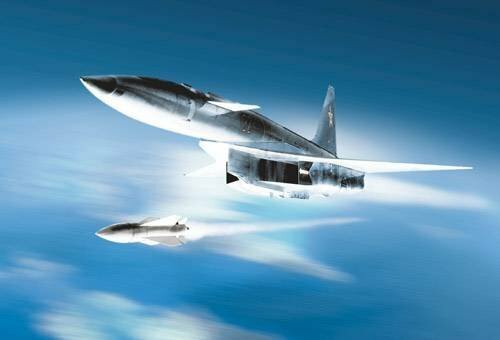
The most realistic way of dealing with aircraft carriers to the Soviet command was the creation of an aviation strike complex. It was supposed to consist of an ultra-high-speed aircraft that could detect a aircraft carrier connection in a given area, and a hypersonic rocket capable of exceeding the speed of sound 4 – 5 times the speed of sound, penetrating a powerful aircraft carrier system and hitting it with a nuclear charge.
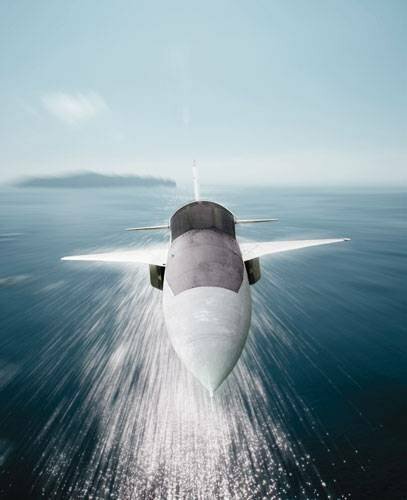
The maximum range of destruction of sea anti-aircraft missile systems of that time was 160 km, height - 30 km, and the speed of the targeted target - 775 m / s. This meant that the planes were available to strike at altitudes up to 25 km and speeds up to 2650 km / h.
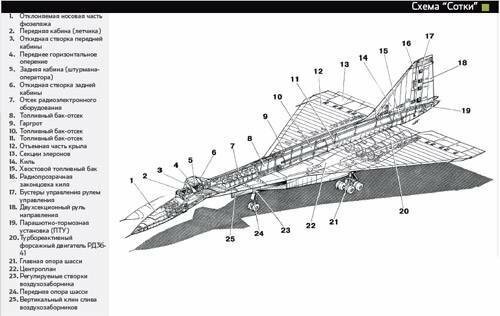
None of the supersonic strategic strike aircraft developed in the USSR at the end of the 1950s in the USSR fit these parameters. The Tupolev design bureau 135 and Myasishchev M-52 aircraft were made mainly of aluminum alloys and designed for maximum speeds of 2000 – 2500 km / h. True, the Myasishchev Design Bureau also developed another strategic bomber of titanium and alloyed steel alloys, M-56. The aircraft was able to withstand the kinetic heating of the skin to 3000С and reach speeds in excess of 3000 km / h. However, initially it was designed as a strategic bomber, designed for combat load in 9 t, and had an excessive take-off weight of about 230 t.
Weaving
The aircraft carrier hunter should have an take-off mass of about 100 t, a cruising flight speed of 3000 km / h and a ceiling of 24 km. When approaching the target of the aircraft at this speed and altitude, the radars of the Americans did not have time to send an anti-aircraft missile at it. Neither fighter-interceptors nor anti-aircraft missiles could hit a promising strike aircraft in the rear hemisphere.
The new aircraft should have a range of 6000 – 8000 km and carry at least two cruise missiles with a range of 400 – 600 km - this would allow it not to enter the zone of reach of air defense assets. The rocket itself was supposed to be a unique product - to reach a speed seven times higher than the speed of sound, to reach the target autonomously and attack it.
The State Committee for Aviation Engineering offered to participate in the competition for such an aircraft by the design bureau of Tupolev, Sukhoi and Yakovlev - they decided not to touch Mikoyan, since his bureau was overloaded with work on the future MiG-25. The implication was that the competition would win the "bomber" Tupolev design bureau, and the "exterminating" design bureau were attracted for the appearance of competition. Moreover, Tupolev had a “135 project” in development - all that remained was to increase his speed to the required 3000 km / h. Contrary to the expectation, the “exterminatory” design bureau enthusiastically took on a non-core topic. In the Sukhoi design bureau, the project was headed by Oleg Samoilovich. The layout was chosen according to the “duck” scheme with front horizontal tail and insulated engine nacelles, air intakes of which protruded beyond the front edge of the wing. According to the initial calculations, the take-off weight was equal to 102 t, whence the informal name of the project “product 100” or simply “weaving” came from.
Collapse of the patriarch
In July, 1961, the Scientific and Technical Council was held, which summarized the results of the competition. The first to report was the Tupolev Design Bureau. The “135 project” was completely destroyed: the plane was too heavy (the take-off mass of the 190 t) and did not pass on the speed indicators - the cruising speed of 2500 km / h instead of the required 3000 km / h. The system of protection of Tupolev was built in terms of economy of public funds: it is more profitable to build one type of universal, especially the already developed aircraft - the “135 product”. He could solve both strategic tasks, including nuclear strikes on the territory of the United States, as well as long-range naval aviation.
The second about his "project Yak-35" reported Alexander Yakovlev. The aircraft resembled the American B-58 Hustler and Myasishchevsky M-52, had a take-off weight of 84, the cruising speed of 3300 was km / h. At the end, Yakovlev attacked the patriarch of bomber aviation: “Andrei Nikolayevich suggests staying on aluminum. This means regression in aircraft technology. We do not do anything new, but we need to move forward and develop new materials - titanium, steel. The Tupolev Design Bureau simply slows down the progress of aviation! ”Tupolev jumped up and shouted:“ Boy, what do you understand in steel? I worked with steel planes when you went under the table! Do you want to ruin the country? ”Yakovlev said nothing.
Then Pavel Sukhoi presented his T-4 (“100”) aircraft project. The machine, like the Yak-35, met the requirements of the Air Force. The final conclusions decided to do after the next meeting of the Council in September 1961 of the year. Andrei Tupolev, on an emergency basis, gave the command to prepare the 125 aircraft for the competition, being developed to replace the Tu-22. But "125-ka" was originally created for other performance characteristics and speeds up to 2500 km / h. Tupolev did not have time to remake it under 3000 km / h. Therefore, at the second scientific and technical council, the “125 project” did not pass for exactly the same reasons that 135 was rejected. The winner was the project of Sukhoi. After some time, Peter Dementiev, Chairman of the State Commission on Aviation Engineering, came to the Sukhoi Design Bureau and directly asked Pavel Osipovich to abandon the project in favor of Tupolev and give him all the materials: “This topic belongs to Tupolev. “Sorry,” answered Sukhoi, “but I won the contest, not Andrei Nikolayevich. Therefore, I will not give up the topic. " After some time, Tupolev himself called Sukhoi: “Pasha, you can make good fighters, but the bombers do not. This topic is mine, give up. " "Just because I can make good fighters, I will make a good bomber," snapped
Dry. Such stubbornness did not add to the designer friends in the industry.
The only flight copy of the T-4, the 101, in 1975, was sent to eternal parking at the Air Force Museum in Monino. Fragments of the 102 aircraft were exhibited in the hangar of the Moscow Aviation Institute (MAI), but were subsequently cut into scrap metal. The same fate befell the partially assembled 103 aircraft
Engines
Such a unique aircraft required no less unique engines that could operate in conditions of unprecedented high temperatures, rarefied air, and unconventional fuel. Initially, three different types of engines were supposed to be installed on the T-4, but in the end they settled on one - РД36-41, the development of which was carried out by the Rybinsk OKB-36 (now NPO Saturn). The engine was a distant relative of the powerful, engineless Soviet 1950-s of the VD-7, which, in particular, equipped the 3M Myaschev bombers. The aircraft engine received a single-shaft 11-speed compressor, an afterburner and a two-stage air-cooled turbine of the first-stage blades, which made it possible to increase the gas temperature in front of the turbine to 950K. The creation of the RD36-41 took a total of about ten years, and at its base other, no less unique engines were created: RD36-51А stood on the passenger Tu-144D, RD36-51В - on the M-17 high-altitude scout M-36 “Stratosphere”, RD35-XNUMX was used in testing the Spiral orbital plane.
Missiles
No less important than the aircraft itself was its main armament - the X-33 hypersonic rocket, the development of which also began in the Sukhoi Design Bureau, but was later transferred to the Dubninsky branch of the OKB-155 (now Raduga ICD). The rocket had to go autonomously to the target along the aeroballistic trajectory at an altitude greater than 30 km at a speed that was 6,5 – 7 times the speed of sound. After reaching the target area, she herself found an aircraft carrier warrant, figured out the aircraft carrier in it and attacked it. It was an unprecedented task at that time - to carry it out, the X-33 installed its own radar station and an inertial navigation system, which included digital computers for the first time. The complexity of the rocket control system is not inferior to the aircraft.
Head over heels
A lot was new in the T-4 booth. For the first time in the country, an indicator of a navigation-tactical situation was developed for it, where on-screen radar data on the television screen was superimposed on an electronic image of microfilmed maps covering the surface of almost the entire globe.
When designing the aircraft, the designers constantly encountered a wide variety of problems that had never before been encountered. For example, in the layout of the aircraft that won the competition, the landing gear did not fit into the compartment intended for it. To get out of the situation, rather exotic solutions were offered - the air intakes were carried out on the “back”, and after entering the specified course, the plane had to turn the cabin down and so make the flight. When landing, the bomber had to roll over again to its original state.
No less fantastic was another solution, which found embodiment in the plane. With a fuselage diameter of just 2 m at a speed under 3000 km / h, the protruding lantern of the pilot's cockpit created tremendous resistance, and the designers decided to use a deflectable nose. When flying at an altitude of 22 – 24, there is no visibility as such, there is a black sky around, so the nose is raised and the flight takes place exclusively by instruments. When landing, it deviates downward and the pilot gets an excellent view through the opened windshield. This idea was met with hostility by the military, and only the enthusiasm and authority of the chief test pilot of Sukhoi Design Bureau Vladimir Ilyushin, the son of the legendary aircraft designer, allowed the Air Force to be convinced. Ilyushin also insisted on installing a periscope for a review ahead — in case of an accidental failure of the bow deflection mechanism. A similar solution subsequently found application in civilian Tu-144 and Concorde.
By the way, the fairing itself brought a lot of problems to the developers, and its creation was one of the most difficult tasks. It was supposed to be radio transparent (radar antennas were placed inside) and at the same time withstand huge strength and temperature (up to 4000C) loads. As a result, honeycomb material was developed on the basis of glass fillers impregnated with heat-resistant binder. The fairing itself was a five-layer design, in which the main load was carried by the middle layer with a thickness of just 1,5 mm. Outside the fairing was covered with thermal and weather resistant silicone coating.
In flight
In the spring of 1972, the first flight copy of the T-4 (the “101 product”) was ready for flight tests, but due to the summer fires of forests and peatlands around Moscow, thick smoke and visibility spread over the runway of LII
them. Gromova was almost zero. Therefore, the first flight took place only 22 August 1972 of the year. The plane was piloted by Hero of the Soviet Union Vladimir Ilyushin and navigator Nikolay Alferov. At the first stage, only nine flights were performed, with the first five being conducted with an uncleared chassis. The plane was controlled well, did not require increased attention from the pilot, the transition of the sound barrier was calm, and the moment of its overcoming was noted only by instruments. The military, who closely followed the tests of the aircraft, came to his delight and ordered the first batch of 1975 vehicles in the coming five-year period (1980 – 250 years)! For a car of this class is a record circulation.
The end of the "weave"
The Tushinsky Machine-Building Plant (TMZ), which built an experimental batch of seven aircraft for the Sukhoi Design Bureau, could not mass-produce them, especially in the quantities ordered. The only plant that could master such an order is Kazan Aviation. In Kazan, training has begun training equipment for the production of the newest bomber. This meant that the Tupolev Design Bureau lost its main production base. Neither Tupolev himself, nor his patron, Minister of Aviation Industry Peter Dementiev could allow this to happen. Under the pretext of releasing a modified version of the Tu-22 (and in fact, a completely new Tu-22M), Sukhoi was “squeezed out” from the Kazan plant.
In the meantime, the second stage of testing began. 22 On January 1974, the tenth flight of the "weave" took place, on which the T-4 reached an altitude of 12 km and a speed of M = 1,36. At this stage, it was supposed to bring the speed up to 3000 km / h (M = 2,8) and start testing the 102 machine with a standard set of radio equipment.
Sukhoi was offered to build the first 50 aircraft at the Tushino Machine-Building Plant, suggesting to completely rebuild it, which was unlikely due to lack of funds. But Dementiev deprived Sukhoi of this small chance. At a regular meeting with the Minister of Defense, he persuaded him to close the T-4 program, deploying the production of wings for the newest Soviet fighter MiG-23 at TMZ. Grechko agreed, and in March 1974, all work on the tests of the T-4 stopped without explanation.
Until his death 15 September 1975, Pavel Sukhoi did not receive an exhaustive answer about the reasons for the freezing of the T-4 project. Only
28 January 1976 of the year issued an order of the Ministry of Aviation Industry under the number 38, which closed the work on the program "products 100». By the same order, Peter Dementiev designated the reason: “In order to concentrate forces and funds on the creation of the Tu-160 aircraft”.
The 101 aircraft was sent to eternal parking at the Moninsky Museum, where it remains to this day. In the 1976 year, after the order was issued, the Sukhoi Design Bureau presented an estimate of the cost of the T-4 aircraft, which at the prices of that time amounted to a fantastic amount of 1,3 billion rubles. There was a noise in the government, but this last surge of emotions along the "weave" led to nothing.
Unsinkable
Not a single aircraft in the USSR, either before or after the T-4, had such a number of original designs. Virtually all of the major components, systems and components of the aircraft were developed at the level of inventions - they were registered around 600. It was a truly giant breakthrough in the field of aircraft construction. Only here at the time of closing the topic, the plane could no longer solve its main task - the breakthrough of the air defense of a carrier warrant and the destruction of an aircraft carrier. As, however, neither the Soviet submarines with the high-speed torpedoes "Squall" and cruise missiles, nor the atomic missile cruisers could solve this.
On the other hand, the Tu-160 supersonic strategic bomber that replaced him in modern wars was also not needed. Having consumed no less cash.
Predecessors and analogues of the strategic bomber T-4
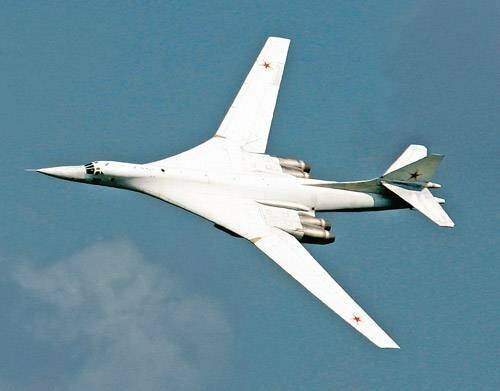
1981
TU-160 rocket carrier
The last Soviet strategic bomber. Take-off weight 267 t, cruising speed 850 km / h, maximum - 2000 km / h, range - up to 14 000 km. Armament - up to 40 t guided missiles and aerial bombs. Standardly - two revolving launchers with six strategic and tactical cruise missiles X-55 and X-55. The most expensive Soviet aircraft is a multi-mode strategic bomber Tu-160. Created primarily for the breakthrough of the US air defense system, it failed in its task. It is still being produced in small series.
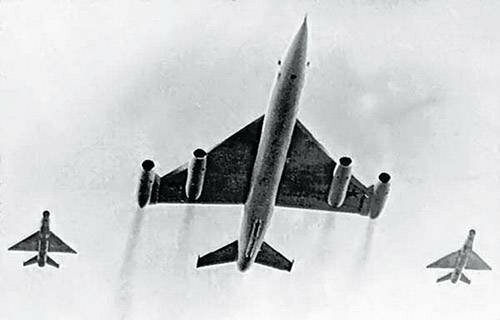
1959
M-50
A revolutionary experimental supersonic strategic bomber, created under the leadership of Vladimir Myasishchev in OKB-23. With take-off weight in 175 t, the aircraft was supposed to develop a cruising speed of 1500 km / h (maximum 1950 km / h) and carry 20 t free-fall high-power bombs in the fuselage compartment to a range of 7400 km at an altitude of 16,5 km.
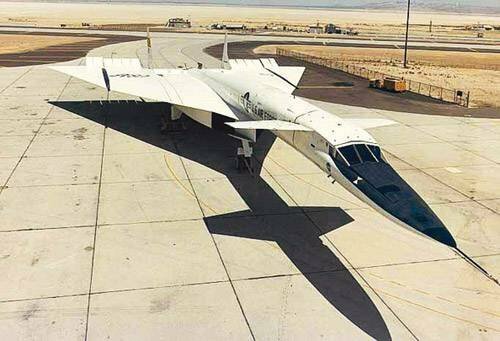
1964
XB-70 Valkyrie
Experimental American titanium supersonic strategic bomber, created by North American. With take-off weight in 240 T, an aircraft with a maximum speed of 3220 km / h at an altitude of 21 km was supposed to deliver bombs and missiles with thermonuclear warheads to a range of up to 12 000 km. This aircraft was not launched into the series.
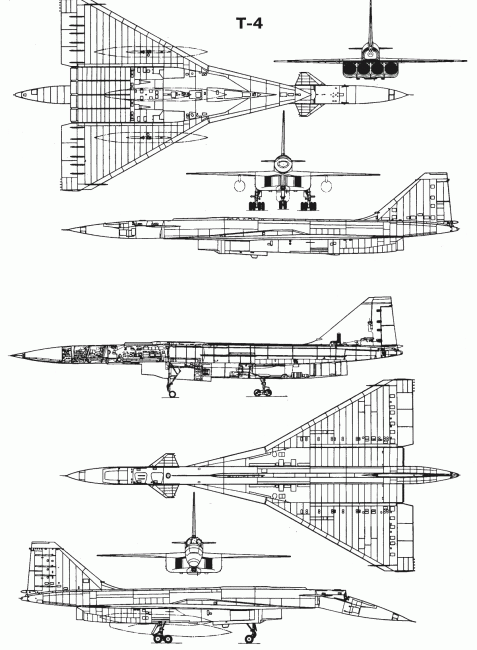
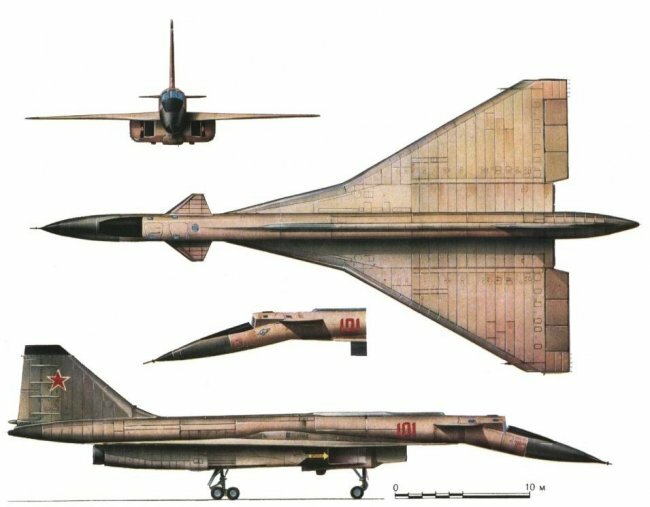
Information